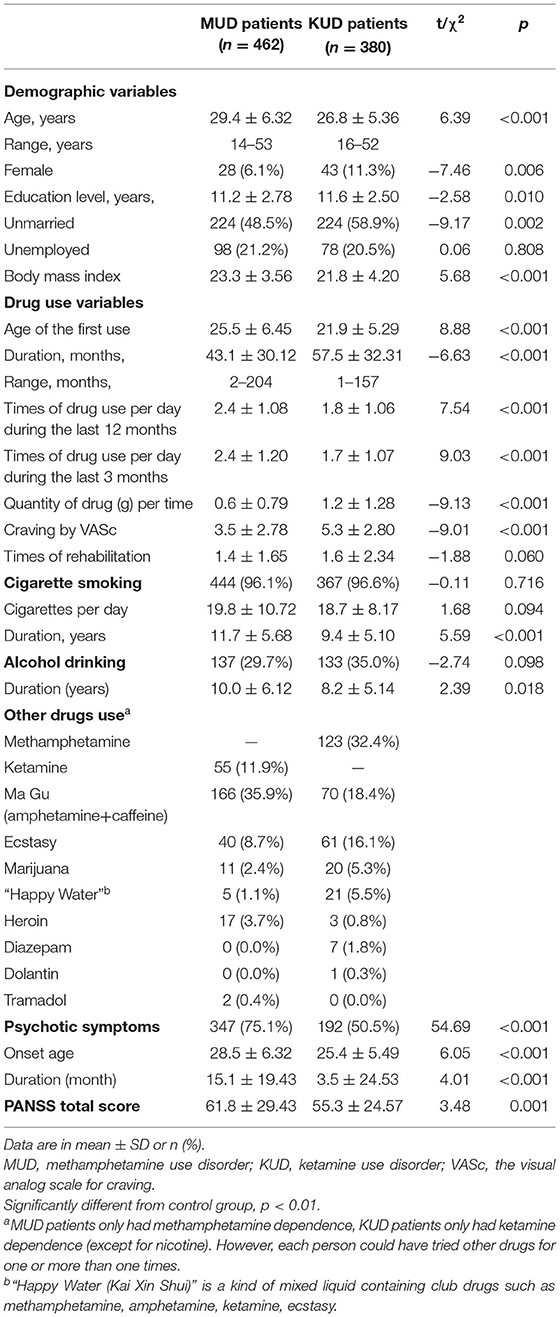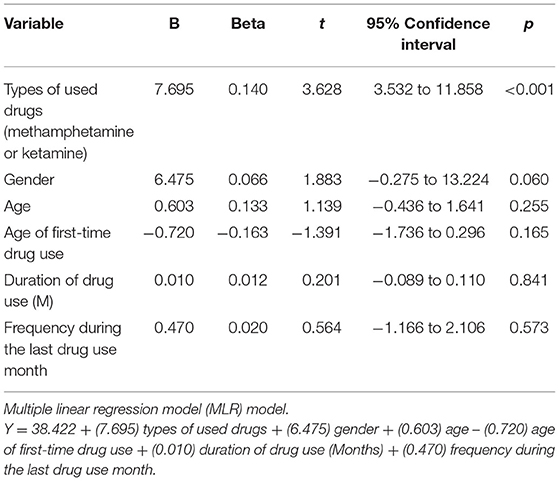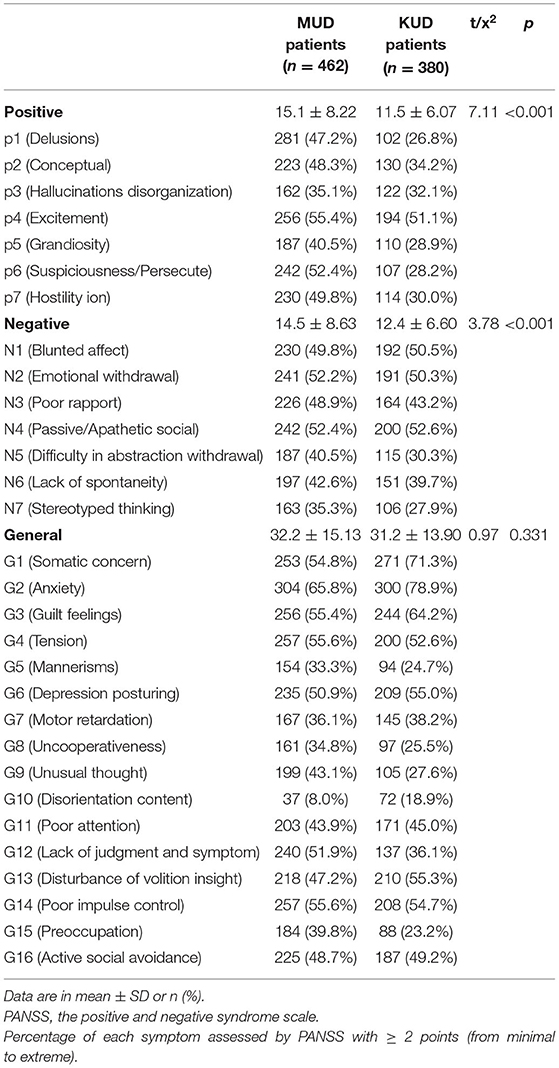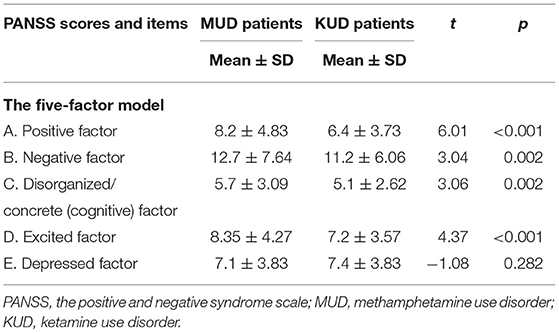- 1Department of Psychology, The First Affiliated Hospital of Nanchang University, Nanchang, China
- 2The Fourth People's Hospital of Urumqi, Urumqi, China
- 3Department of Psychiatry, Zhejiang Provincial People's Hospital, People's Hospital of Hangzhou Medical College, Hangzhou, China
- 4Department of Psychiatry, The Second Xiangya Hospital, Central South University, Changsha, China
- 5Department of Psychiatry, Sir Run Run Shaw Hospital, Zhejiang University School of Medicine, Hangzhou, China
Background: Methamphetamine and ketamine are commonly used club drugs. Both of them have been reported to mimic psychotic symptoms of schizophrenia. However, the prevalence and detailed features of psychotic symptoms among methamphetamine use disorder (MUD) and ketamine use disorder (KUD) patients are largely unknown. This study aimed to measure psychotic symptoms among patients with MUD and KUD.
Methods: A total sample of 842 patients from voluntary drug rehabilitation centers, including 462 MUD patients and 380 KUD patients, were invited to this study. The Positive and Negative Syndrome Scale (PANSS) was applied to assess psychotic symptoms in these two groups of patients.
Results: The prevalence of psychotic symptoms was significantly higher among MUD patients than KUD patients (75.1 vs. 50.5%, 95% CI: 3.532 – 11.858, p < 0.001). Compared with KUD patients, MUD patients were more likely to experience positive symptoms (PANSS positive scores: 11.5 ± 6.07 vs. 15.1 ± 8.22, P < 0.001) and negative symptoms (PANSS negative scores: 12.4 ± 6.60 vs. 14.5 ± 8.63, P < 0.001), but not general symptoms (PANSS general scores: 31.2 ± 13.90 vs. 32.2 ± 15.13, P < 0.001).
Conclusions: The current study found that more than half of MUD and KUD patients experienced psychotic symptoms, and that patients with MUD are more likely to experience positive and negative symptoms than patients with KUD. The findings provide a new perspective for exploring the neuropathological mechanism of psychotic symptoms of schizophrenia.
Introduction
The use of synthetic drugs such as methamphetamine and ketamine has been recognized as an increasingly serious and important public health issue in China and other countries (1–3). A series of studies indicate that chronic use of both methamphetamine and ketamine can lead to psychotic symptoms (4–6), which are mainly manifested as persistent hallucinations, delusions, and negative symptoms.
The experience of psychotic symptoms ranged from 26 to 46% among people with methamphetamine use disorder (MUD) (7). A study with 292 MUD patients from a drug rehabilitation center in Malaysia showed that 47.9% of them had a history of psychotic symptoms (8). Studies show that patients with ketamine use disorder (KUD) have a relatively lower risk of psychotic symptoms than those of MUD patients, around 8% (9). In drug-free healthy individuals, low-dose administration of either ketamine or amphetamine produced positive symptoms (such as conceptual disorganization) and euphoria. Ketamine mainly produced perceptual changes, concrete ideation, and unusual mannerisms, negative symptoms, and disrupted delayed recall. Amphetamine mainly produced hostility, grandiosity, and somatic concern. The findings from the above study indicate that glutamate and DA may differentially contribute to psychosis (10). A recent systematic review and meta-analysis further confirmed that ketamine induced psychosis-like symptoms in healthy volunteers (11).
The neuropathological mechanisms of psychotic symptoms are not fully understood. Both methamphetamine and ketamine use-induced psychotic symptoms can mimic symptoms of schizophrenia. Methamphetamine has been used for the study of the dopamine (DA) model of schizophrenia (12). Ketamine, as an N-methyl-D-aspartate (NMDA) antagonist, has often been studied for the glutamate model of schizophrenia (13). DA plays a well-recognized role in a variety of neurophysiologic functions such as cognition, mood and reward (14). Methamphetamine dysregulates both DA transmission and DA reuptake, and it mainly acts on DA transporter (DAT) and the vesicular monoamine transporter 2 (VMAT2) to inhibit the reabsorption of DA and promote the release of DA in the Nucleus Accumbens (NA) via the sigma receptor (15). Ketamine primarily impairs NMDA glutamate receptor neurotransmission, and it has been suggested to increase cortical glutamate release via indirect inhibition of GABAergic interneurons, implicating in the pathophysiology of schizophrenia (16).
Although a line of study has shown that the psychotic symptoms caused by methamphetamine and ketamine are similar to those of schizophrenia. The prevalence and detailed features of psychotic symptoms (including positive, negative and general symptoms) among methamphetamine use disorder (MUD) and ketamine use disorder (KUD) patients are largely unknown. The aim of this study was to measure psychotic symptoms among patients with MUD and KUD. Based on previous studies, this study assumed that the prevalence of positive and negative symptoms would be higher among MUD patients than KUD patients. The findings from this study may provide a preliminary basis for clinical interventions of MUD and KUD associated psychosis, and give a new perspective for exploring the neuropathological mechanism of psychotic symptoms of schizophrenia.
Methods
Recruitment
This cross-sectional study assessed the prevalence of psychotic symptoms in a clinic-based sample of KUD patients and MUD patients. We recruited 380 KUD patients and 462 MUD patients from two rehabilitation centers in mainland China (Guangzhou Baiyun Voluntary Drug Rehabilitation Center in Guangdong Province and Kangda Voluntary Drug Rehabilitation Center in Hunan Province) from January 2012 to October 2016. Drug use (methamphetamine or ketamine) was validated via urine toxicology screen and self-report data. All participants were diagnosed through a semi-structured interview (Structured Clinical Interview for DSM-IV-TR, Axis I, Patient Version, SCID-I/P) by experienced psychiatrists (with more than 5 years of clinical experience). The Positive and Negative Syndrome Scale (PANSS) was used to assess psychotic symptoms in these two groups of patients. Before enrolling patients into this study, all psychiatrists who involved in current study were trained to administer the PANSS and SCID-I/P with good reliability (>0.80). The inclusion criteria were: inpatients from drug rehabilitation center; after detoxification and had 2 weeks of drug abstinence; met diagnosis for MUD or KUD; used methamphetamine or ketamine for more than 12 months; 18 years of age or older; willing to participant, being able to communicate in Chinese. The exclusion criteria were: suffering from other severe mental and/or physical illnesses; have a history of brain trauma; and have other substance use disorders (except for nicotine).
Ethics
Informed consent was obtained from all patients in the study. The procedures were performed in accordance with the Declaration of Helsinki. The ethical approval for this study was obtained from the Ethics Committee of the Second Xiangya Hospital, Central South University (No. S163, 2011).
Measures
Sociodemographic and Drug Use Information
Sociodemographic and drug use information, such as age, gender, education, age of the first use, quantity of drug (g) per time, drug craving, and times of rehabilitation were collected by self-reported questionnaires. Methamphetamine or ketamine craving was assessed by the Visual Analog Scale for Craving (VASc) (17). The VASc displays a scale from 0 (left, no craving) to 10 (right, most extreme craving).
The Positive and Negative Syndrome Scale
The Positive and Negative Syndrome Scale (18) is a 30-item scale designed to obtain a measure of positive (items P1 to P7) and negative (items N1 to N7) symptoms in schizophrenic patients, as well as a measure of general psychopathology (items G1 to G16). All 30 items are rated on a 7-point scale: 1 = absent, 2 = minimal, 3 = mild, 4 = moderate, 5 = moderate–severe, 6 = severe, 7 = extreme. Factorial analyses of subscales found that a five-factor model better captures PANSS structure in schizophrenia samples (19). In the five-factor model, smaller groupings of items represent the following symptoms: positive (items P1, P3, P5, G9), negative (items N1, N2, N3, N4, N6, G7), disorganized/concrete (items P2, N5, G11), excited (items P4, P7, G8, G14), and depressed (items G2, G3, G6) symptoms.
Statistical Analyses
Statistical analysis was performed using the SPSS for Windows (Version 23, SPSS Inc., Chicago, IL, USA) software package. Descriptive statistics were used to examine demographic, drug use, and psychotic characteristics. Independent sample t-tests or χ2-square tests were performed to determine group differences in demographic characteristics, substance use profiles, and psychotic symptoms between these two groups. Multiple linear regression models have been applied to evaluate the impact of types of used drugs (methamphetamine or ketamine), gender, age, age of first-time drug use, duration of drug use (months), and frequency during the last drug use month on psychotic symptoms (PANSS total score). An alpha level of 0.01 was set to determine statistical significance.
Results
Sociodemographic and Drug Use Characteristics
This study included 842 drug users (462 MUD patients and 380 KUD patients). Demographic and drug use characteristics of patients with MUD and KUD are shown in Table 1.
Factors Predicting Psychotic Symptoms
Multiple linear regression models were applied to evaluate the predictors (demographic and drug use factors) for psychotic symptoms (PANSS total score). As shown in Table 2, only types of used drugs (methamphetamine or ketamine) were associated with PANSS total score, indicating that MUD patients experienced more psychotic symptoms than KUD patients did (p < 0.001).
Psychotic Symptoms in MUD Patients and KUD Patients
A total of 75.1% (n = 347) MUD patients and 50.5% (n = 192) KUD patients experienced psychotic symptoms (Table 1). Compared with KUD patients, MUD patients were more likely to suffer from psychotic symptoms (95% CI: 3.532–11.858, p < 0.001). The scores of PANSS were compared between these two groups. We find that compared with KUD patients, MUD patients were more likely to experience positive symptoms (11.5 ± 6.07 vs. 15.1 ± 8.22, P < 0.001) and negative symptoms (12.4 ± 6.60 vs. 14.5 ± 8.63, P < 0.001), but not general symptoms (31.2 ± 13.90 vs. 32.2 ± 15.13, P = 0.331) (Table 3). The proportion of each symptom in both groups, including each item of the PANSS positive, negative, and general symptoms, are also shown in Table 3. A five-factor model of positive, negative, disorganized/concrete, excited, and depressed symptoms was also compared between two groups (Table 4).
Discussion
Principal Findings
The current study assessed the prevalence and detailed features of psychotic symptoms among MUD and KUD patients. This study found that 75.1% MUD patients and 50.5% KUD patients from drug rehabilitation centers in China experienced psychotic symptoms, indicating that MUD patients are more likely to suffer from psychotic symptoms (including positive and negative symptoms) than KUD patients. However, MUD patients and KUD patients showed no group differences in overall general symptoms.
Psychotic Symptoms in MUD Patients and KUD Patients
Compared with previous studies, our study found relatively high prevalence of psychotic symptoms in MUD patients and KUD patients, especially in MUD patients. One study reported that the prevalence of psychotic symptoms ranged from 26 to 46% in MUD patients (7). Another study reported that 47.9% MUD patients had history of psychotic symptoms (8). A study found that only 8% KUD had psychotic symptoms (9). However, our study found more than half of KUD patients and two-thirds of MUD patients experienced psychotic symptoms.
This study found that, compared with KUD patients, MUA patients were more likely to experience both positive and negative symptoms, but not general symptoms. Previous studies suggest that methamphetamine mainly causes psychotic symptoms by causing DA system dysfunction, acting on DA transmission in the central nervous system via the inhibition of the DA transporter and the VMAT2, and leading to the increase of DA concentration in the mesolimbic, nigrostriatum, and mesocortical, resulting in psychotic symptoms, mainly positive symptoms (6, 20). Furthermore, in the nigrostriatum, dysregulated DA neuron firing can abnormally highlight irrelevant stimuli, thereby producing percepts and thoughts with aberrant salience, resulting to delusions and hallucinations (10, 21). In terms of methamphetamine use induced negative symptoms, one possible explanation is that the reduction of the signal-to-noise ratio of adaptive phasic signaling has the potentiality to reduce the appetitive properties of a given reward, thereby leading to motivation and anhedonia, and other negative symptoms.
Research indicates that ketamine produces psychotic symptoms through dysfunction in the glutamate system. As a high affinity non-competitive antagonist of NMDAR, ketamine has been shown to mimic more negative symptoms than active symptoms of psychotic behavior in previous studies (10, 21). A line of study found that ketamine can produce positive and negative symptoms similar to schizophrenia with long-term use (22, 23), which is consistent with our results. A preclinical study found that ketamine causes psychotic episodes by significantly increasing synaptic glutamate release in the cortex and striatum (24).
High prevalence of psychosis among MUD patients and KUD patients in current study indicates that both the glutamate and DA systems directly or indirectly interact with psychotic symptoms (4, 10, 13). The psychotic symptoms were more easily induced by MA than ketamine, indicating that the dysfunction of the glutamate system may cause psychotic symptoms through indirect (not direct) action on the DA system. Methamphetamine or amphetamine induced hyper-dopaminergic states would be associated with the more vulnerability of psychosis (25). Previous studies proved that modulation of the DA system affects cortical glutamate levels (mainly in the prefrontal lobe) and local glutamate release; glutamate levels can affect DA release in the striatum; and the administration of ketamine can lead to the increase of DA release in the striatum. Low glutamate release or insufficient activation of NMDA receptors on cortical GABA interneurons may lead to hyperactive striatal dopaminergic activity (13, 26–28). Clinically, the use of DA receptor antagonists for ketamine-induced psychosis further provides evidence of the interaction of glutamate and DA (29). Thus, we speculate that the glutamate system can use a common pathway that interacts with the DA system to contribute to the occurrence of psychotic symptoms.
In short, comparing psychotic symptoms induced by the nonmedical use of ketamine and methamphetamine, we have demonstrated that some features of psychotic symptoms in MUD and KUD patients are highly similar to schizophrenia. Our study indicates the significance of identifying and treating psychotic symptoms in MUD and KUD patients, and provides a preliminary basis for clinical identification of the characteristic of psychotic symptoms between schizophrenia and substance use disorder.
Limitations
This study has some limitations that need to be considered. First of all, we only assessed residual psychotic symptoms but not acute effects of methamphetamine and ketamine. All participants were from voluntary drug rehabilitation centers, and they were not randomly sampled, so the representativeness is limited. Secondly, most patients in the present study were male, so we did not assess gender differences for psychotic symptoms. Thirdly, some drug use variables were different between MUD patients and KUD patients. Compared with MUD patients, KUD patients showed an earlier age of the first use, longer duration of ketamine use, higher quantity of drug use per time, and higher drug craving level. However, this study found more MUD patients experienced psychotic symptoms than KUD patients. The underlying mechanism needs to be further researched. Lastly, some MUD or KUD patients also used other drugs. However, this study excluded patients with other substance use disorders (excluding nicotine).
Conclusion
In conclusion, this study found that psychotic symptoms are commonly reported by MUD patients and KUD patients from drug rehabilitation centers, and that MUD patients are more likely to suffer from psychotic symptoms (but not general symptoms) than KUD patients. These findings indicate the importance of assessing psychotic symptoms among these two groups of patients. It also provides a new perspective for exploring glutamatergic model and dopaminergic model of psychosis.
Data Availability Statement
The raw data supporting the conclusions of this article will be made available by the authors, without undue reservation.
Ethics Statement
The study protocol has been approved by Ethics Committee of the Second Xiangya Hospital, Central South University (No. S163, 2011). The patients/participants provided their written informed consent to participate in this study.
Author Contributions
YL conceived the study and took the lead in writing the manuscript. YL and MX did the literature review. TL did the statistical analyses. YL, TL, and MX drafted the report. YL, CQ, and QW collected the data. TL, MX, and JT interpreted the data and commented on the manuscript. JT supervised the study. All authors contributed to the article and approved the submitted version.
Funding
This study was supported by the National Natural Science Foundation of China (Grant No. 81671325 to YL) and the Hunan Provincial Natural Science Foundation of China (Grant No. 2020JJ4794 to YL).
Conflict of Interest
The authors declare that the research was conducted in the absence of any commercial or financial relationships that could be construed as a potential conflict of interest.
Publisher's Note
All claims expressed in this article are solely those of the authors and do not necessarily represent those of their affiliated organizations, or those of the publisher, the editors and the reviewers. Any product that may be evaluated in this article, or claim that may be made by its manufacturer, is not guaranteed or endorsed by the publisher.
Acknowledgments
We acknowledge all the professionals from Voluntary Drug Rehabilitation Centers who helped a lot in data collection. The authors thank all the patients who participated in this study.
References
1. Du P, Li K, Li J, Xu Z, Fu X, Yang J, et al. Methamphetamine and ketamine use in major Chinese cities, a nationwide reconnaissance through sewage-based epidemiology. Water Res. (2015) 84:76–84. doi: 10.1016/j.watres.2015.07.025
2. Sun HQ, Bao YP, Zhou SJ, Meng SQ, Lu L. The new pattern of drug abuse in China. Curr Opin Psychiatry. (2014) 27:251–5. doi: 10.1097/YCO.0000000000000073
3. Liao Y, Tang YL, Hao W. Ketamine and international regulations. Am J Drug Alcohol Abuse. (2017) 43:495–504. doi: 10.1080/00952990.2016.1278449
4. Malhotra AK, Pinals DA, Adler CM, Elman I, Clifton A, Pickar D, et al. Ketamine-induced exacerbation of psychotic symptoms and cognitive impairment in neuroleptic-free schizophrenics. Neuropsychopharmacology. (1997) 17:141. doi: 10.1016/S0893-133X(97)00036-5
5. Zweben JE, Cohen JB, Christian D, Galloway GP, Salinardi M, Parent D, et al. Psychiatric symptoms in methamphetamine users. Am J Addict. (2004) 13:181–90. doi: 10.1080/10550490490436055
6. Bramness JG, Gundersen OH, Guterstam J, Rognli EB, Konstenius M, Loberg EM, et al. Amphetamine-induced psychosis–a separate diagnostic entity or primary psychosis triggered in the vulnerable? BMC Psychiatry. (2012) 12:221. doi: 10.1186/1471-244X-12-221
7. Glasner-Edwards S, Mooney LJ. Methamphetamine psychosis: epidemiology and management. CNS Drugs. (2014) 28:1115–26. doi: 10.1007/s40263-014-0209-8
8. Sulaiman AH, Said MA, Habil MH, Rashid R, Siddiq A, Guan NC, et al. The risk and associated factors of methamphetamine psychosis in methamphetamine-dependent patients in Malaysia. Compr Psychiatry. (2014) 55 Suppl 1:S89–94. doi: 10.1016/j.comppsych.2013.01.003
9. Fan N, Xu K, Ning Y, Rosenheck R, Wang D, Ke X, et al. Profiling the psychotic, depressive and anxiety symptoms in chronic ketamine users. Psychiatry Res. (2016) 237:311–5. doi: 10.1016/j.psychres.2016.01.023
10. Krystal JH, Perry EB Jr, Gueorguieva R, Belger A, Madonick SH, Abi-Dargham A, et al. Comparative and interactive human psychopharmacologic effects of ketamine and amphetamine: implications for glutamatergic and dopaminergic model psychoses and cognitive function. Arch Gen Psychiatry. (2005) 62:985–95. doi: 10.1001/archpsyc.62.9.985
11. Beck K, Hindley G, Borgan F, Ginestet C, McCutcheon R, Brugger S, et al. Association of ketamine with psychiatric symptoms and implications for its therapeutic use and for understanding schizophrenia: a systematic review and meta-analysis. JAMA Netw Open. (2020) 3:e204693. doi: 10.1001/jamanetworkopen.2020.4693
12. Grant KM, LeVan TD, Wells SM, Li M, Stoltenberg SF, Gendelman HE, et al. Methamphetamine-associated psychosis. J Neuroimmune Pharmacol. (2012) 7:113–39. doi: 10.1007/s11481-011-9288-1
13. McCutcheon RA, Krystal JH, Howes OD. Dopamine and glutamate in schizophrenia: biology, symptoms and treatment. World Psychiatry. (2020) 19:15–33. doi: 10.1002/wps.20693
14. German CL, Baladi MG, McFadden LM, Hanson GR, Fleckenstein AE. Regulation of the dopamine and vesicular monoamine transporters: pharmacological targets and implications for disease. Pharmacol Rev. (2015) 67:1005–24. doi: 10.1124/pr.114.010397
15. Hedges DM, Obray JD, Yorgason JT, Jang EY, Weerasekara VK, Uys JD, et al. Methamphetamine Induces Dopamine Release in the Nucleus Accumbens Through a Sigma Receptor-Mediated Pathway. Neuropsychopharmacology. (2018) 43:1405–14. doi: 10.1038/npp.2017.291
16. Stone JM, Dietrich C, Edden R, Mehta MA, de Simoni S, Reed LJ, et al. Ketamine effects on brain GABA and glutamate levels with 1H-MRS: relationship to ketamine-induced psychopathology. Mol Psychiatry. (2012) 17:664–5. doi: 10.1038/mp.2011.171
18. Kay SR, Fiszbein A, Opler LA. The positive and negative syndrome scale (PANSS) for schizophrenia. Schizophr Bull. (1987) 13:261–76. doi: 10.1093/schbul/13.2.261
19. Wallwork RS, Fortgang R, Hashimoto R, Weinberger DR, Dickinson D. Searching for a consensus five-factor model of the Positive and Negative Syndrome Scale for schizophrenia. Schizophr Res. (2012) 137:246–50. doi: 10.1016/j.schres.2012.01.031
20. Hsieh JH, Stein DJ, Howells FM. The neurobiology of methamphetamine induced psychosis. Front Hum Neurosci. (2014) 8:537. doi: 10.3389/fnhum.2014.00537
21. Stone JM, Erlandsson K, Arstad E, Squassante L, Teneggi V, Bressan RA, et al. Relationship between ketamine-induced psychotic symptoms and NMDA receptor occupancy: a [(123)I]CNS-1261 SPET study. Psychopharmacology. (2008) 197:401–8. doi: 10.1007/s00213-007-1047-x
22. Frohlich J, Van Horn JD. Reviewing the ketamine model for schizophrenia. J Psychopharmacol. (2014) 28:287–302. doi: 10.1177/0269881113512909
23. Moghaddam B, Krystal JH. Capturing the angel in “angel dust”: twenty years of translational neuroscience studies of NMDA receptor antagonists in animals and humans. Schizophr Bull. (2012) 38:942–9. doi: 10.1093/schbul/sbs075
24. Lisek M, Ferenc B, Studzian M, Pulaski L, Guo F, Zylinska L, et al. Glutamate Deregulation in Ketamine-Induced Psychosis-A Potential Role of PSD95, NMDA Receptor and PMCA Interaction. Front Cell Neurosci. (2017) 11:181. doi: 10.3389/fncel.2017.00181
25. Cassidy CM, Balsam PD, Weinstein JJ, Rosengard RJ, Slifstein M, Daw ND, et al. A perceptual inference mechanism for hallucinations linked to striatal dopamine. Curr Biol. (2018) 28:503–14.e4. doi: 10.1016/j.cub.2017.12.059
26. Gao WJ, Krimer LS, Goldman-Rakic PS. Presynaptic regulation of recurrent excitation by D1 receptors in prefrontal circuits. Proc Natl Acad Sci U S A. (2001) 98:295–300. doi: 10.1073/pnas.98.1.295
27. Cohen SM, Tsien RW, Goff DC, Halassa MM. The impact of NMDA receptor hypofunction on GABAergic neurons in the pathophysiology of schizophrenia. Schizophr Res. (2014) 167:98–107. doi: 10.1016/j.schres.2014.12.026
28. Howes OR. McCutcheon and J Stone: Glutamate and dopamine in schizophrenia: an update for the 21st century. J Psychopharmacol. (2015) 29:97–115. doi: 10.1177/0269881114563634
Keywords: methamphetamine use disorder, ketamine use disorder, psychotic symptoms, positive symptoms, negative symptoms, schizophrenia
Citation: Luo T, Xiao M, Qi C, Wu Q, Tang J and Liao Y (2022) Features of Psychotic Symptoms in Methamphetamine Use Disorder Patients and Ketamine Use Disorder Patients: A Cross-Sectional Study. Front. Psychiatry 12:786622. doi: 10.3389/fpsyt.2021.786622
Received: 30 September 2021; Accepted: 10 December 2021;
Published: 18 January 2022.
Edited by:
Xiaochu Zhang, University of Science and Technology of China, ChinaCopyright © 2022 Luo, Xiao, Qi, Wu, Tang and Liao. This is an open-access article distributed under the terms of the Creative Commons Attribution License (CC BY). The use, distribution or reproduction in other forums is permitted, provided the original author(s) and the copyright owner(s) are credited and that the original publication in this journal is cited, in accordance with accepted academic practice. No use, distribution or reproduction is permitted which does not comply with these terms.
*Correspondence: Yanhui Liao, bGlhb3lhbmh1aUB6anUuZWR1LmNu
 Tao Luo
Tao Luo Meng Xiao
Meng Xiao Chang Qi
Chang Qi Qiuxia Wu
Qiuxia Wu Jinsong Tang
Jinsong Tang Yanhui Liao
Yanhui Liao


